Art the Human Body No Reference to the Natural World

Caravaggio, The Doubting of Thomas, c. 1601-02, oil on canvas, 107 x 146 cm (Sanssouci Pic Gallery)
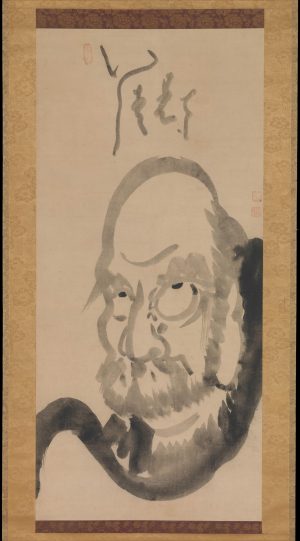
Hakuin Ekaku, Portrait of Daruma, mid-18th century, Edo flow Japan, hanging scroll, ink on newspaper, 117.5 x 54 cm (The Metropolitan Museum of Art)
Naturalism is resemblance to the "real world," every bit we see information technology around united states of america. The more naturalistic a work, the more it looks similar our world, and the less naturalistic, the less so.
Representational versus non-representation
For extremes, we volition compare a work by Caravaggio with a work by Hakuin Ekaku, a Japanese Zen Buddhist monk. Caravaggio's Italian Baroque The Doubting of Thomas is highly naturalistic, whereas Hakuin's portrait of Daruma rejects naturalism. Both paintings are representational, which means that they both depict something, as opposed to non-representational works like Pollock's Autumn Rhythm (Number 30), where there is no visual movie subconscious in the lines.
Verism
In Caravaggio'southward image, the face of Thomas, who leans down to look directly at the wound in Jesus' side, is rendered in minute, realistic particular. His hairs are individually rendered, his features distinct and recognizable, his skin browned from the dominicus and with dirt.
Caravaggio found his models for holy figures in the streets, and their humble weather condition are carefully depicted in his paintings. All this adds up to naturalism, and perhaps even to the highest degree of naturalism, referred to every bit verism.
Moving toward abstraction
Ekaku's portrait of Daruma, on the other paw, is recognizable every bit a human face, but all the elements have all been rendered somewhat abstractly — that is, in some style deviating from or ignoring the natural globe, simplifying or altering it for effect. We might also say that Ekaku's image is stylized — designed according to the principles of a particular style rather than being beholden to the way things look in "the real earth."
This does not brand it less "practiced" equally a piece of work of art, and also does not hateful that the artist was less skilled. Rather, it is just a different, less naturalistic style, designed to suit different goals. Here, the emphasis is not on the not bad Buddhist sage's literal advent (he died over a millennium earlier this work was made), but on his wisdom, embodied in his giant, upturned eyes and vast forehead.
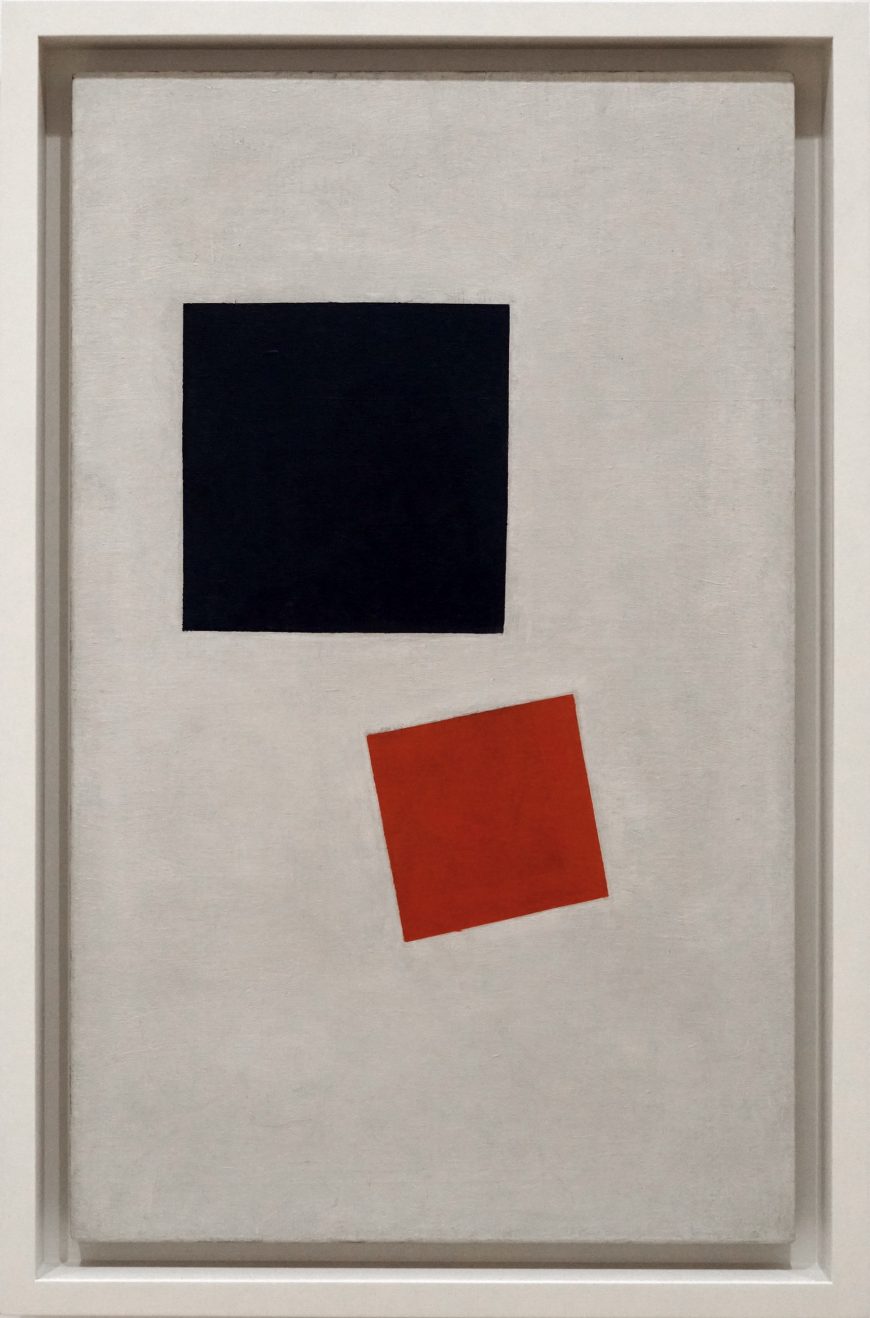
Kazmir Malevich, Painterly Realism of a Boy with a Knapsack – Color Masses in the Fourth dimension, 1915, oil on canvass, 71.i x 44.v cm (The Museum of Modernistic Art)
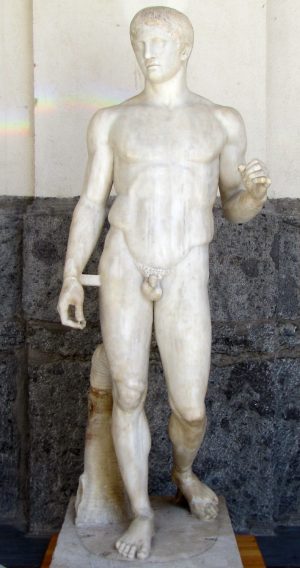
Polykleitos, Doryphoros, c. 450-40 B.C.Eastward., aboriginal Roman marble copy of a lost bronze original, 211 cm (Archaeological Museum, Naples)
Non-representational fine art
The farthest extent of abstraction is not-representational or not-objective fine art, in which the subject is not simply abstract, just wholly absent-minded.
This type of fine art, which many viewers find highly challenging, makes little or no reference to the natural world, such as Kazimir Malevich's geometric paintings such as Painterly Realism of a Male child with a Knapsack – Colour Masses in the Fourth dimension.
In such works, we are in a purely formal world, with no recognizable subject in the work simply the work, itself, and where the tools of visual analysis are the but points of entry into the work.
Idealization
At that place is one other way, though, that nosotros can speak of naturalism. Instead of contrasting information technology with abstraction, we tin can contrast it with realism.
We can meet that the Doryphoros is highly naturalistic, in that he looks very much like a living person. On the other hand, he presents his culture's physical ideal of symmetry, youth, fitness, and, indeed, relaxation.
If we are existence honest, we would accept to admit that while a person could look like this, rather few of us practice. It is therefore highly arcadian. In this sense, the piece of work lacks realism — since, in a way, according to ancient Greek views, it is as well perfect.
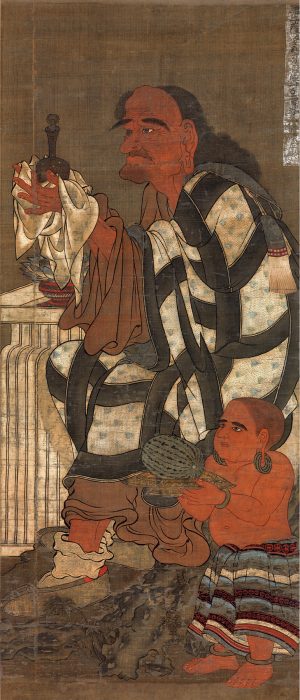
Satsubari, The 2d of the Sixteen Rakan, late 14th century, hanging coil; ink, color, and gold on silk, 115.three x 49.3cm (Mary Griggs Shush collection)
Naturalism and realism
Permit's have another example — a fourteenth century Japanese painting, The 2nd of the Sixteen Rakan (Rakan are figures in Buddhism who protect Buddhist law and bless donors). Here the figure does not appear naturalistic, in that the work is clearly a painting, with a loose manner and exaggeration of features.
On the other hand, the work is highly realistic, in that the artist has presented usa with a figure that is ordinary or even slightly grotesque, rather than arcadian. He is erstwhile, wrinkled and bent, his earlobe hanging low (stretched out by large aureate earrings) as a marker of his by wealth. His apparel are rumpled, his socks slipping downwardly. While the epitome is non very naturalistic, information technology is withal highly realistic.
Naturalism, realism, brainchild and idealization
Disentangling naturalism from realism is tricky, and the terms are sometimes used interchangeably, despite their important differences.
Naturalism and realism might or might not appear in the same work. An epitome might be naturalistic and realistic, like The Doubting of Thomas, or naturalistic and arcadian, equally is Doryphoros.
Alternately, a piece of work might be abstracted and realistic, like the Second Rakan, or abstracted and idealized, like St. John in the Lindisfarne Gospels). A diagram presents the nexus of these terms, and we might plot but near every work of fine art in this book somewhere within information technology .
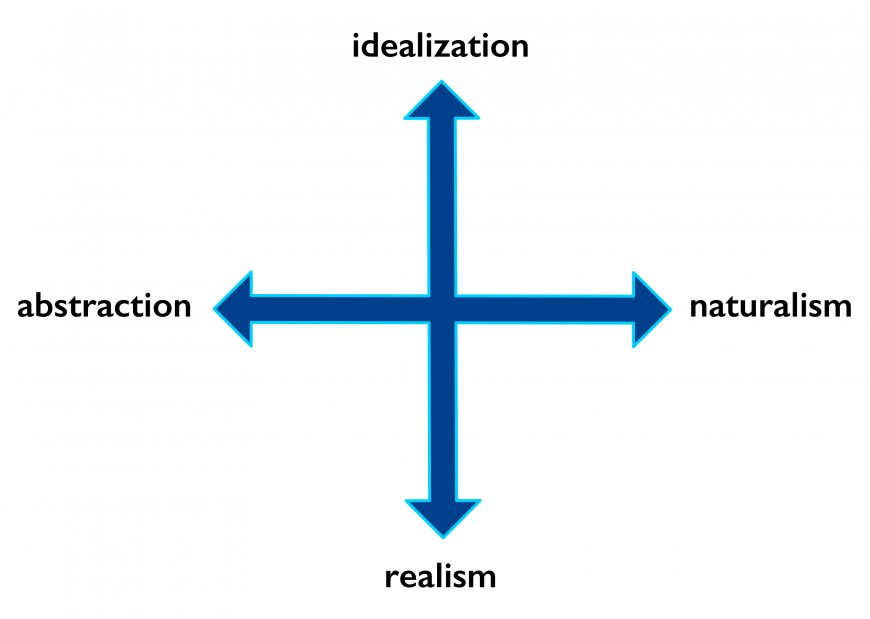
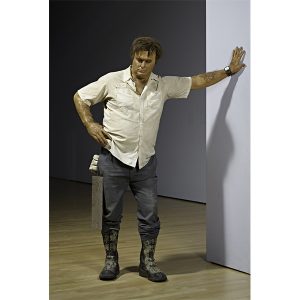
Duane Hanson, Slab Human. 1974-75, vinyl resin and fiberglass, polychromed in oil (Cantor Arts Center)
Also real?
Some works, of form, like those by Duane Hanson, have both forms of naturalism.
His life-size sculptures of people revel in their ordinary nature, and are too startlingly lifelike — veristic — then much so that they are frequently mistaken for real people when on display in museum exhibitions.
I take been fooled by two of them, over the years. One was dressed equally a museum guard and another as a workman. Even though I had seen Slab Man dozens of times, when his gallery was under structure and he was surrounded by carts of equipment and tools, I was fooled anew.
Cite this page as: Dr. Asa Simon Mittman, "Naturalism, realism, brainchild and idealization," in Smarthistory, July 11, 2019, accessed April 26, 2022, https://smarthistory.org/naturalism/.
Source: https://smarthistory.org/naturalism/
0 Response to "Art the Human Body No Reference to the Natural World"
Post a Comment